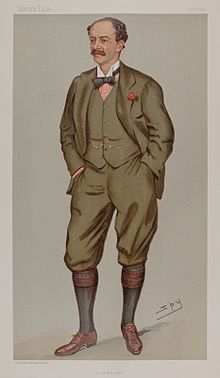Andrew Murray, 1st Viscount Dunedin


Andrew Graham Murray, 1st Viscount Dunedin GCVO PC (* 21st November 1849 , † 21st August 1942 ) was a Scottish - British politician of the Conservative Party and a lawyer . He was a member of the House of Commons for several years , between 1903 and 1905 Minister for Scotland and as a peer member of the House of Lords and from 1913 to 1932 also Lord of Appeal in Ordinary .
Life
Attorney, MP and Lord Advocate
After attending Harrow School graduated from Murray, whose father Solicitor was studying law at Trinity College of the University of Cambridge and received in 1874 his legal approval to the Scottish Bar Association ( Scots Bar ). He then took up an activity as a lawyer ( Advocate ) and received the title of Crown Attorney ( Queen's Counsel ) for his legal services in 1891 .
Shortly thereafter, on October 9, 1891, he was elected as a candidate for the Conservative Tories for the first time as a member of the House of Commons and represented the constituency of Buteshire until February 28, 1905 . During this period he was Solicitor General of Scotland from 1891 to 1892 and again from 1895 to 1896.
In May 1896, Murray succeeded Charles Pearson as Lord Advocate Attorney General and held this office for seven years until he was replaced by Charles Dickson in October 1903. At the same time, he was appointed Privy Councilor in 1896 and served as Lord Lieutenant of the 1901-1905 County of Bute .
Scotland Minister, Lord Justice and Member of the House of Lords
Subsequently, on October 9, 1903, Prime Minister Arthur James Balfour appointed him to succeed the resigned Alexander Bruce as Secretary for Scotland in his cabinet and retained this function until he was replaced by John Hope, 1st Marquess of Linlithgow on February 2, 1905.
After leaving the House of Commons and government, Murray was raised to the nobility by a letters patent dated March 9, 1905 as a hereditary peer with the title Baron Dunedin, of Stenton in the County of Perth to a member of the House of Lords . At the same time he became in 1905 as successor to John Balfour, 1st Baron Kinross President of the Supreme Civil Court of Scotland ( Lord President of the Court of Session ) and as such at the same time Lord Justice General and thus President of the Supreme Court of Justiciary . He held these offices until 1913 and was then replaced by Alexander Ure . In 1908 he was also Knight Commander of the Royal Victorian Order .
Thereupon Lord Dunedin became Lord Judge on October 14, 1913 ( Lord of Appeal in Ordinary ) and held this office for almost 20 years until his resignation on April 6, 1932. In 1922 he was raised to the Knight Grand Cross of the Royal Victorian Order.
On February 17, 1926, he was awarded the hereditary title of Viscount Dunedin, of Stenton in the County of Perth for his longstanding political and legal services . However, since his only son died in 1934 and there was no living male descendant at the time of his death on August 21, 1942, the titles of Baron and Viscount expired, so that he was the first and only Viscount Dunedin.
Publications
- The divergencies and convergencies of English and Scottish law , 1935
Web links
- Mr Andrew Murray at Hansard (English)
- Entry in Leigh Rayment Peerage
- Lords of Appeal in Ordinary 1876-2009 in Peerages
- Proof of publication in the Open Library
Individual evidence
- ↑ United Kingdom peerage creations 1801 to 2012 (Leigh Rayment Peerage)
- ↑ Extinct United Kingdom Baronies (Cracroft's Peerages)
| personal data | |
|---|---|
| SURNAME | Murray, Andrew, 1st Viscount Dunedin |
| ALTERNATIVE NAMES | Murray, Andrew Graham, 1st Viscount Dunedin (full name) |
| BRIEF DESCRIPTION | Scottish-British lawyer and politician (Conservative Party) |
| DATE OF BIRTH | November 21, 1849 |
| DATE OF DEATH | August 21, 1942 |